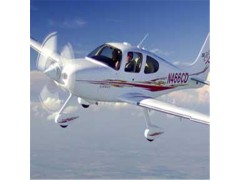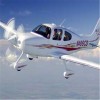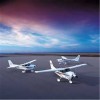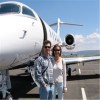It's simple...
If you own an aircraft, you can earn money by renting it out to our members.
If you don't yet own one, we can help you buy one.
We'll take care of the aircraft on your behalf.
Your aircraft's rental is optimized with our leaseback program benefits:
Reduced aircraft management fees
You choose maintenance facility
You control aircraft rates
What's An Aircraft Leaseback Program?
Many flying clubs, flight schools and aircraft dealers provide services wherby aircraft owners can make their aircraft available for rental through an agreement commonly referred to as a "leaseback" (there are many different names for this same thing, but let's use leaseback for this introduction). These "leaseback operators" take care of scheduling, dispatching, billing and often maintenance of the aircraft. To a certain degree, the aircraft owner may be involved in overseeing the aircraft's operation and management so as to treat the leaseback's taxable status as an active (vs. passive) investment.
Why Would I Leaseback My Aircraft?
Some of the principal reasons for putting an aircraft in a leaseback are to:
keep the aircraft flying often and prevent idle deterioration - planes like to fly
earn rental income to help pay for the aircraft
fly the aircraft for less than the cost of renting an identical one
claim the aircraft as a depreciating, tax-deductible business asset
If properly structured, a leaseback can be a profitable investment. However, some leaseback programs are designed to maximize income for the leaseback operator, not the aircraft owner, so be careful of the agreement terms when choosing wher to leaseback your aircraft. See below for common pitfalls.
How Does Leaseback Work?
From an aircraft owner's perspective, a leaseback is a profit & loss business, with rental income and expenses. After taking gross rental income and subtracting all expenses, whatever is left is the net profit or loss of the leaseback. Additionally, the value of the aircraft may be depreciated over time to generate a tax-deductible loss, which is usually the main reason aircraft owners do a leaseback. If the leaseback is channeled through an S-Corporation or LLC that flows to a personal tax return, the depreciation loss could erase most or even all income taxes. As the old saying goes, sometimes, the fastest way to make more money isn't to make more money, but to pay less taxes.
An aircraft's gross rental income may be controlled by altering the aircraft's rental demand, which in turn is controlled by the rental price, general upkeep and appeal of the aircraft, scheduling availability and restrictions on the operation of the aircraft. Pricing and appeal are major factors.
While understanding leaseback income is easy, the leaseback expenses are more complex and vary based on many factors, including the type of aircraft. In general, the expenses tend to rank as follows, from highest to lowest:
Fuel consumption
Maintenance (inspections, repairs, overhauls, upgrades)
Management or Operations (Ops) Fees
Insurance
Taxes (sales, use, property)
Tie-down or hangared parking
The amount of influence the aircraft owner can have over these expenses varies. In a given geographic region, certain expenses are very similar among different leaseback operations, especially fuel prices. However, the next two big expenses, maintenance and management, could differ significantly and can make a leaseback profitable or not.
Why Choose Advanced Flyers For Leaseback?
Advanced Flyers is owned by aircraft owners. It was designed to improve leaseback performance beyond what competing flying clubs could offer. We do this through improved efficiency and relations with all the owners without sacrificing quality, resulting in higher per-hour net profit margins for owners. We have a combined 30+ years of experience working with leasebacks and large aircraft fleets.
Nearby competing flying clubs are controlled by elected individuals or non-profit volunteers with no leaseback or ownership involvement or "skin in the game" and are therefore unqualified to represent aircraft owner's interests. By putting your aicraft for rent with us, you can be confident we know how to operate and take care of your aircraft.
Below are three additional benefits of renting your aircraft through us:
#1: No Aircraft Management Fees
Newly added leaseback aircraft need time to develop a following and generate revenue. Therefore, we won't charge any management or operations (ops) fees during the first year of leaseback. This chart highlights typical management expenses in competing leasebacks. With us, you'll keep that money.
Our competitors charge anywere from $14 to $25 per flight hour, depending on rental rate. This can make it difficult or impossible for you to have a net profit with your leaseback aircraft. After your free first year of leaseback, we charge only a fraction of what others charge. We want owner's planes to be profitable! Otherwise those planes risk being moved to another club or sold and the loss of the rental aircraft would affect our members.
Some popular training leaseback planes fly hundreds of hours each year. With our reduced fees, this basically translates into getting a FREE engine at TBO (time between overhaul). For example, a Cessna 172SP or Piper Archer engine is overhauled after 2000 hours at a cost of about $30K (including all labor costs). If you saved $15 / hour by leasing to us instead of another club, you would keep roughly $30K! Hence you get a free engine.
#2: YOU Choose Maintenance Facility
We allow our leaseback aircraft owners to decide who maintains their aircraft. In our competitor's leasebacks, owners are often required to use a specific facility (usually that of the operating club or flight school). If so, it's reasonable to suspect that you'd end up paying for more maintenance at a higher price than necessary. Remember that maintenance is a major leaseback expense, so the choice of maintenance facility can greatly affect your leaseback's net income.
#3: YOU Control Rental Rates
By letting you set your aircraft rental rates, you can regulate your aircraft's rental demand and profit margin. On the other hand, some leaseback operators dictate that they alone set the rental rates. Since those operators usually collect hourly fees regardless of the rates, they have an incentive to set rates too low, which could result in:
high demand and flight hours, thus:
more hourly management fees,
more frequent maintenance,
very low profit margin, if any, for the owner
Will You Leaseback My Aircraft?
It depends on your aircraft's condition. We're happy to add well-maintained and visually appealing aircraft to our fleet. But other than that, we're not picky as to the make, model and age. However, there are certain aircraft that are known to be more popular for rental than some odd model few people have flown before.
See our Aircraft Wanted for Rental list for more information.
Tell Me More about Ownership & Tax Benefits
If you'd like to get an in-depth understanding of the leaseback process and how we may be able to help you achieve your goals, please attend one of our monthly Aircraft Ownership and Leaseback Seminars
If you'd like help finding and purchasing an aircraft for leaseback, we can assist with that. Please contact us to discuss it.






